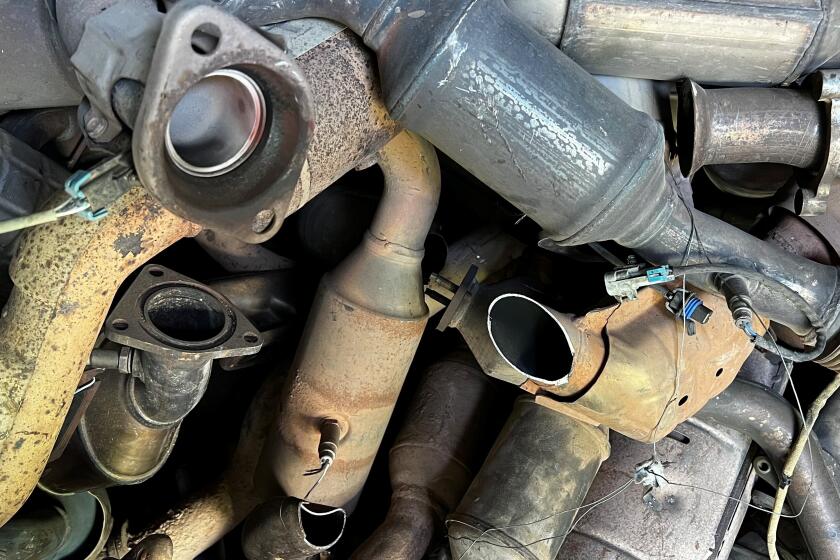L.A. Mission selling low-income apartment building; residents must move

Los Angeles Mission selling transitional apartments; former homeless residents have until June 15 to move out
- Share via
After spending two years at the Los Angeles Mission overcoming a methamphetamine addiction, Patrick Vincer graduated from the skid row shelter to the Christian ministry’s apartment building in Hollywood.
Vincer, 49, a former carnival worker, said mission staff told him in January that he had two years to get his life together at the 45-unit building facing the Hollywood studio where “Hannah Montana” and “The Jazz Singer” were filmed. During that time, he would receive job-development and financial-literacy training and have a chance to save money to transition to living on his own.
But a little over two months later, the mission’s staff announced that the building was being sold and the tenants — up to 90 men, women and children — had to be out by June 15, Vincer said. Mass evictions of apartment buildings are skyrocketing in Los Angeles — the number of units proposed for removal from the rental market tripled between 2013 and 2014, city housing records show. Hollywood is one of the hot spots.
NEWSLETTER: Sign up for a weekly briefing on California business news
But although low-income households in rent-controlled buildings can receive $10,000 to $20,000 for moving expenses and extra time to regroup, residents at 1417 Bronson Ave. were turned out with no relocation benefits. The city in 2001 granted the mission’s low-income housing project an exemption, the records say.
“Putting people back into society, I think that’s priceless,” said tenant Andrew Glenn, 52. “This is creating homelessness.”
“They said we should have faith in the Lord and the Lord would see us through it,” Vincer said he was told by mission officials.
The Weingart Foundation, a Los Angeles philanthropy, donated the Bronson Avenue apartments to the Los Angeles Mission in 1994. Mission President Herb Smith said the ministry was selling the building because the program wasn’t working as it should. It was too far from the mission’s skid row services, he said.
The sale proceeds will be set aside for a new transitional housing facility at a location to be determined later, Smith said. He declined to name the buyer or the sale price. Many tenants had ample time to save money, and nobody would be left to become homeless again, he said.
“We met our moral obligation to them,” Smith said. “No one’s going to be out on the street. They will all have housing, even if they have to come back to the mission.”
Several tenants, however, said the mission had left them to fend for themselves.
Returning to skid row, where some spent decades in the streets in the throes of addiction, is their greatest fear, they said.
“That’s like returning to your own vomit,” said Kenneth Bryant, 60, a Bronson Avenue resident. “That’s why God delivered us from there in the first place.”
Plagued by the double bind of low wages and high prices, Los Angeles is the least affordable rental market in the country, according to Harvard University’s Joint Center for Housing Studies. Tenants at the Bronson, all formerly homeless people fighting various addictions, are the poorest of the poor. Some receive $221 monthly welfare payments or disability benefits, typically less than $1,000 a month. Many have felony records that limit their employment and housing opportunities.
The mission, which reported $12.5 million in revenues in 2013, obtained a $1-million subsidized loan five years ago from the Federal Home Loan Bank of San Francisco to rehabilitate the apartment building. Smith said there were no conditions on either the foundation’s gift or the loan barring the sale. Weingart Foundation spokeswoman Susan Dunn confirmed the foundation’s gift was not an obstacle.
Vincer has found a studio apartment on the edge of downtown. But the $550 monthly rent — he was paying $250 in “occupancy fees” at the Bronson — will be a stretch, he said.
He earned a community college heating and air conditioning maintenance certification with the mission’s help, but could only find work as an itinerant laborer, Vincer said.
“The Los Angeles Mission’s a good deal; I don’t hold any grudge against them,” Vincer said. “I just feel they left us out in the dark.”
Bryant, 60, is still looking for a place. He said he appreciated that the mission helped him overcome a crack cocaine and alcohol addiction, but he gave back “100 %” by helping with the institution’s outreach and public relations.
On a YouTube video, Laker star Kobe Bryant praises Kenneth Bryant’s (no relation) “perseverance” in coming back. The video was made for TakePart, the digital magazine arm of Participant Media, which promotes social causes through film productions, including “Food Inc.” and “The Help.”
“Out of the four guys on the video, I’m the only one still clean and sober,” Bryant said.
Bryant said his security job for a film production company is not enough to help his daughter through college and pay for a place that will let him in.
“It used to be do you have the money? It ain’t like that no more,” said another displaced tenant, Melvin Colmer. “Now there’s a background check, waiting list and do you even qualify?”
With the mission’s help, Colmer is moving into a renovated former flophouse on skid row. He said “it wasn’t right the way it happened” but is satisfied with the outcome.
“I didn’t want to come back downtown, after being here in my addiction for years,” Colmer said. “But I’m going to let God take me where he will.”
More to Read
Sign up for Essential California
The most important California stories and recommendations in your inbox every morning.
You may occasionally receive promotional content from the Los Angeles Times.











